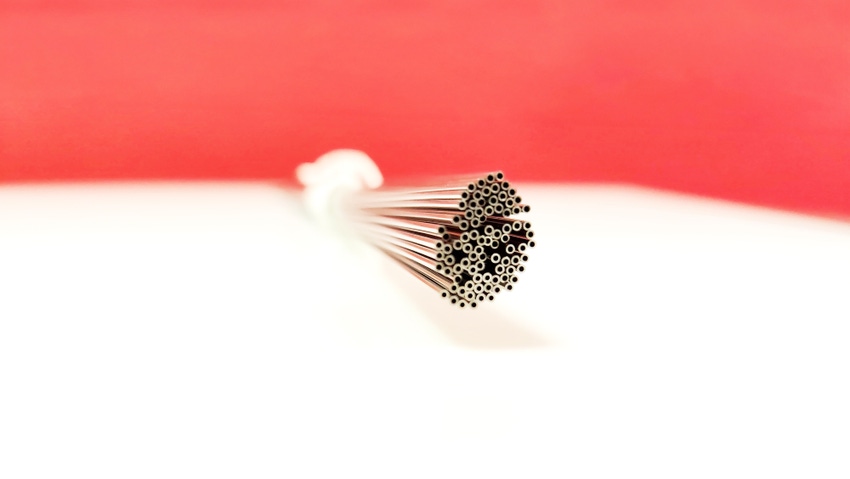What Is a Hypodermic Tube?
Hypotubing, which was originally developed for use in guidewires and needles, has become popular among the world’s surgical robot makers and acts as a substitute for a cable assembly that would otherwise be made up entirely of mechanical cable.

Commonly referred to as hypodermic needle tubing, hypotubing is virtually the same product used to collect blood during one’s yearly physical or if you’ve ever received an intravenous line (IV) solution, it is the very same tubing that is used to gain access to veins and other body vessels. Today however, hypotubing has proliferated among the world’s makers of surgical robots and acts as a substitute for a cable assembly that would otherwise be made up entirely of mechanical cable. Typically combined with tungsten ultrafine mechanical cable, these unique surgical robotics mechanical cable assemblies are among the components used to achieve pitch and yaw characteristics in a robot’s end effectors.
Interestingly, its new(ish) role in surgical robotics motion actuation isn’t entirely new at all.
As mentioned, hypotubing was developed to be used as needles for injecting or withdrawing body fluids. But in addition to this most common use case, such tubing has been used for decades in guidewires, like those used to install stents in obstructed vessels. Likewise, they have been used for catheter manufacturing as well, along with other catheters and implantable medical technology as well.
Hypotubing materials
Hypotubing is produced using either 304 stainless steel or 316 stainless steel and is welded in drawn tubing.
While the corrosion-resistance of 304 is excellent, the molybdenum contained in 316 stainless steel hypotubing makes it superior to 304 because molybdenum provides for a significant increase in the material’s corrosion resistance. However, 304 stainless steel hypotubing is easier to weld (ie, form/shape) into hypotubing because it possesses a lower melting point and, because it does not contain molybdenum, does not possess a tendency toward forming chromium carbides during welding operations.
Even with the advantages of molybdenum in 316 stainless steel, which adds both value, but also cost, 304 stainless steel provides surgical robotics makers the necessary corrosion-resistance required of their motion components. What’s more, 304 stainless steel also satisfies both the critical strength and rigid factor of safety requirements that allow this less-expensive stainless steel tubing solution to be the go-to material of choice.
And although hypotubing can be produced from virtually any ferrous alloys, given 304 stainless steel’s prominence among surgical robot makers, it’s clear that engineers have decided on the ideal material type for such use cases.
Hypotubing sizing
Hypotubing is available in many stock sizes, known commonly as gauges. For instance, hypotubing can come in sizes such as 10g, 18g, 20g, but can also run from under .01” up to > .10” OD. Each gauge also comes with various wall thicknesses, for instance, an 18g tube can possess a .005” wall.
In the manufacture of mechanical cable assemblies, the goal is to match a stock hypotube option with the tungsten cable’s OD and the tubing’s ID. So, for instance, if a miniature stainless steel mechanical cable possesses a .02” OD, engineers would need a hypotube with a slightly larger ID, such as let’s say .023” for instance, to facilitate proper swaging of the hypotube to the tungsten or stainless steel cable.
Generally speaking, stock hypotubing lists will support most mechanical cable applications, but this isn’t always true.
However, given that among the core reasons to use hypotubing in concert with a length of tungsten cable is to reduce the cost of pricey tungsten cable, choosing tubing from stock sizes lends well to keeping costs responsibly managed. After all, if a length of tungsten cable costs significantly more than pairing tungsten cable with a length of hypotubing, selecting tubing from off-the-shelf options further ensures cost mitigation, which later, can be passed to the sticker price of the robot. And because the robotic-assisted surgery market is currently a boomtown marketplace, anywhere makers can reduce manufacturing costs helps maintain a competitive position amid fierce and noisy global markets.
When the OD of the mechanical cable cannot be properly swaged with the ID of stock hypotubing, it is possible to custom draw the tubing to a unique custom specification. But because this scenario will undoubtedly drive-up materials costs, drawing custom hypotubing should only be considered where quantities justify the added expense.
What do hypotubes do?
As discussed, hypotubing provides a robot’s designers with the means by which to meet and even often exceed the strength, hold, and cost-effective requirements of their end effector cable assemblies. But in addition, hypotubing also just plain fits.
Because a surgical robot must possess a lean footprint, and by extension, allow a surgeon’s fingers, hands, wrists, and arms to perform magnified precision tasks, hypotubing cannot take up space unnecessarily. Therefore, hypotubing, given its infinitesimal geometry, nests nicely into the incredibly tight crevasses, channels, and formfactors of a robot’s appendages. Due to the size of the tungsten cables that are used to mimic the surgeon’s delicate movements are produced using wires that are a fraction of the size of a single human hair, the hypotubing must likewise be diminutive in size as well. Therefore, hypotubing, while conjuring up mental images of long, cylindrical tubes, can be cut to size and thus be used as a sleeve-like cable fitting. This means a length of hypotubing could be as short as .030” if required.
Instead of having to machine sleeve fittings from bar stock or wire, both of which will drive up materials costs, engineers can select hypotubing that is cut to length, which yields the sleeve fitting required to complete the cable assembly. And furthermore, it can be cut with extreme accuracy to lengths within ± .001” or more.
Achieving such tight tolerances represent an urgent demand of cable makers, as surgical robotics makers cannot afford slack in any of the motion control cables meant to perform under tension inside the surgically opened cavity of a human being. Sleeve fittings made from hypotubing are designed to hold tension in the robotic end effectors and to allow for the free, six-degree movement of the same. The length of a fitting is designed to hold a certain amount of tension. So, the length of a hypotube fitting is linearly proportional to the amount of tension the fitting will hold on to the cable.
Sometimes such tungsten cables use longer lengths of hypotubing, commonly as long 12”. The purpose of the long tubes is two-fold:
It defrays the costs of the tungsten cable, because instead of using a foot of pricey tungsten cable, designers are using a length of stainless steel hypotubing to reduce their cable consumption.
Hypotubing also minimizes the stretch the system may experience under a cable assembly that is strictly produced using tungsten cable or even stainless steel alternatives.
Key considerations
The tolerances required of the mechanical cable assemblies that reside inside and facilitate the motion of the surgeon’s hands can be ± .002”. These extraordinarily tight tolerances are essential, specifically due to the lack of lost motion in a surgeon’s natural abilities to manipulate her fingers, hands, wrists, and arms. Said plainly, if the surgeon’s possesses precise control over the motion her hands and fingers can perform, and those motions are entirely regulated by fine motor control, the robot’s end effectors must perform identically.
Tungsten mechanical cable assemblies meant to perform synchronically with a surgeon’s hands, demand that, under tension, there is literally no surplus motion. Hypotubing allows for a cost-effective, malleable cable fitting solution that:
Reduces the quantity of cable required for the assembly, which saves on materials costs.
Ensures precise tubing cutting, which promises that near impossibly tight tolerances are achievable.
Offers many over-the-counter diameters and lengths, which allows engineers to mitigate potentially costly customized cable fitting scenarios.
About the Author(s)
You May Also Like



.png?width=300&auto=webp&quality=80&disable=upscale)
